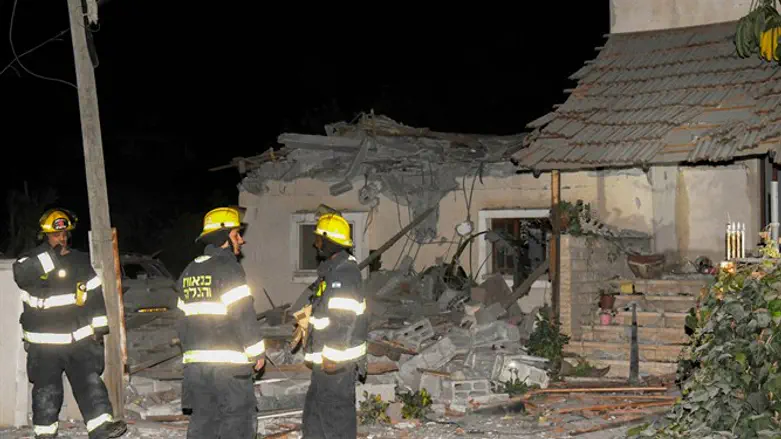
In the lexicon of false terms used to describe Israel’s rightful actions to defend itself, one of the most egregious is the term “disproportionate response”.
Though this term is a mantra for haters of Israel, it also unfortunately works its way into the consciousness of supporters of Israel.
Reasonable people can recognize that Israel, like any state, has a right and obligation to defend its people from attack, and to respond with force when needed. But reasonable people can also recognize that the civilian population of Gaza has a right to live without undo threat from Israeli military might.
So what happens when these two rights appear to be in conflict – what happens if there is a large number of civilian casualties in Gaza when Israel acts to eliminate the military threat from Hamas?

Suddenly, Israel’s right of self-defense becomes contingent upon a low number of civilian casualties. Unfortunately, the term “disproportionate response” has been intentionally used to negate Israel’s right to defend itself. Suddenly, Israel’s right of self-defense becomes contingent upon a low number of civilian casualties. If those casualties seem too high, Israel is called upon to show restraint and to cease eliminating the threat. Furthermore, the term also seems to ignore any Hamas responsibility for those civilian casualties.
Unfortunately, the term “disproportionate response” has been intentionally used to negate Israel’s right to defend itself. Suddenly, Israel’s right of self-defense becomes contingent upon a low number of civilian casualties. If those casualties seem too high, Israel is called upon to show restraint and to cease eliminating the threat. Furthermore, the term also seems to ignore any Hamas responsibility for those civilian casualties.
But it is not axiomatic that a high civilian casualty rate points to a disproportionate use of force. It might or it might not. It is necessary to examine the facts.
And what are the facts?
First and foremost, the evidence indicates that Israel has no desire to inflict harm on Gazan civilians. Israel does not attack in Gaza without cause. The current battle is an Israeli response to Hamas and Islamic Jihad rockets fired at Israeli cities and towns. It is not a cycle of violence; it is an Israeli response to a Hamas act of war.
Even when Hamas attacks Israel and forces it to respond, Israel does what it can get Gazan civilians out of harm’s way. It warns civilians to move away from Hamas military targets. In previous battles it made robo-calls and dropped leaflets warning people to leave areas that it planned to attack.

Israel’s detractors often claim that Gaza is so densely populated that there are no unpopulated areas far enough removed from population centers where Hamas can place its military equipment and personnel. But this is not so; Gaza contains many such unpopulated areas. Second, and this is critical: Hamas deliberately houses its military equipment and personnel in densely populated civilian structures (homes, apartment buildings, schools, hospitals, mosques.) Obviously, a Hamas weapons storage facility placed in a school or hospital will lead to civilian casualties when targeted.
Second, and this is critical: Hamas deliberately houses its military equipment and personnel in densely populated civilian structures (homes, apartment buildings, schools, hospitals, mosques.) Obviously, a Hamas weapons storage facility placed in a school or hospital will lead to civilian casualties when targeted.
If Hamas would house its military equipment and personnel in isolated areas away from civilian centers, there would be few or no civilian casualties when Israel hit Hamas military targets.
Israel’s detractors often claim that Gaza is so densely populated that there are no unpopulated areas far enough removed from population centers where Hamas can place its military equipment and personnel. But this is not so; Gaza contains many such unpopulated areas.
But more importantly, even within densely populated civilian neighborhoods, if Hamas would simply put its military equipment and personnel in buildings that did not house civilians, there would be few, if any, civilian casualties. And this highlights the great distinction between disproportionate response and high civilian casualties.
If Israel was to bomb a whole neighborhood block in order to eliminate a Hamas target, the case could be made for calling it a disproportionate response. But to the contrary, Israel’s responses are pinpoint, surgical, and minimalist – the opposite of disproportionate.
All the videos of Israeli strikes in Gaza (videos put out by both the Israeli military and by Gazan residents) show Israel targeting specific buildings or even specific floors of a building. Gazan civilians don’t flee; they stand nearby and watch. Nearby schools, mosques, hospitals, and residential buildings are generally left intact.
The bottom line is that Hamas deliberately places its military equipment and personnel in schools, hospitals, residences, etc. It strategically and cynically uses its own people as cannon fodder, either to rely on the Jewish conscience against hurting civilians, or to foment hatred against Israel and to bring international pressure on Israel to stop defending itself. Blame for civilian casualties in Gaza falls squarely on Hamas, not on Israel.
Israel ’s task, like any country’s, is to defend its people, and Israel does so through surgical strikes, not disproportionate response. Large numbers of civilian casualties in Gaza are the direct result of decisions and actions by Gazan leadership, and are likely to continue unless Gazan leadership stops using its people as human shields.
It is high time to stop conflating “disproportionate response” with a high number of civilian casualties. They are not synonymous.
Alan Perlman is a retired technical writer from Carmel in the Hevron hills region. His columns have appeared on IsraelInsider.com, as well as the web-sites of Yahoo! News, Aish HaTorah and radio personality Rush Limbaugh.
